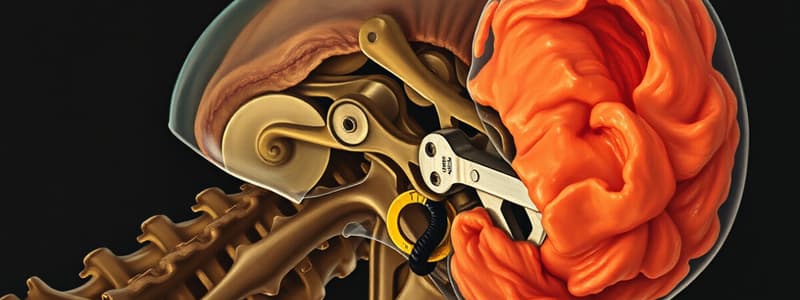Podcast
Questions and Answers
What is the main cause of traumatic brain injury (TBI)?
What is the main cause of traumatic brain injury (TBI)?
- Sports and recreation (correct)
- Assaults (correct)
- Falls (correct)
- Road traffic accidents (correct)
The acceleration/deceleration of a vehicle is not important in brain injury.
The acceleration/deceleration of a vehicle is not important in brain injury.
False (B)
What are the primary measures of brain injury?
What are the primary measures of brain injury?
- Angle of impact and Change in velocity
- Impact duration and Delta-V (correct)
- Linear and Angular acceleration (correct)
- All of the above.
Research on brain injury is always valid and applicable to all scenarios.
Research on brain injury is always valid and applicable to all scenarios.
What are the mechanisms of TBI?
What are the mechanisms of TBI?
According to the biomechanic expert, the size of a motor vehicle involved in a car crash is an important consideration in a brain injury case.
According to the biomechanic expert, the size of a motor vehicle involved in a car crash is an important consideration in a brain injury case.
What kind of TBI injuries can be caused by inertial loading of an MVA?
What kind of TBI injuries can be caused by inertial loading of an MVA?
What are the classifications of TBI? (multiple answers)
What are the classifications of TBI? (multiple answers)
Brain injuries are sustained more with rotation than with just linear movement.
Brain injuries are sustained more with rotation than with just linear movement.
What are some of the limitations or assumptions of brain analysis which can be used in cross-examination? (multiple answers)
What are some of the limitations or assumptions of brain analysis which can be used in cross-examination? (multiple answers)
Study Notes
TBI Med/Legal: Biomechanics in Car Crashes
- Acceleration/deceleration significantly influences brain injury, beyond direct impacts.
- Main causes of Traumatic Brain Injury (TBI): road traffic accidents, sports, falls, and assaults.
- Coup and contracoup injuries arise from frontal and back impacts, leading to concussion symptoms.
- Vehicle impact considerations: intensity, direction, and duration are critical.
- Change in velocity, velocity angle, and impact angle must be evaluated.
- Mild TBI is prevalent; can be assessed radiologically despite often being unnoticed.
Primary Measures of Brain Injury
- Linear acceleration: results from the skull moving forward and backward.
- Angular acceleration: recent studies highlight brain rotation as a significant injury factor, more than linear movement.
Secondary Measures of Brain Injury
- Head Injury Criterion (HIC) and Abbreviated Injury Scale (AIS) are commonly accepted measures.
- Gadd Severity Index also utilized for TBI assessment.
- Common assessment methods include calculating acceleration experienced through physical testing or research analysis.
Impact of Seating Position
- Driver and passenger seating positions during a crash affect injury outcomes.
- Research limitations can arise if focused on specific collision types.
Importance of Incident Data
- Advanced vehicle data (e.g., from TESLA black boxes) aids understanding of velocity changes, acceleration, and impact angles.
- Such data is essential for accurate accident reconstruction and analysis.
Validity and Reliability of Research
- Reliability measures consistency; validity assesses accuracy of findings.
- Many TBI studies may lack external validity due to limited participant demographics (e.g., predominately high-end male athletes).
- Peer-reviewed research may not always apply universally outside studied contexts.
Miscellaneous Notes
- The "laziness question" may imply a challenge in rigorous methodologies for TBI studies.
- Case studies (e.g., MVC) illustrate real-world applications of biomechanical principles in assessing TBI.
Studying That Suits You
Use AI to generate personalized quizzes and flashcards to suit your learning preferences.



